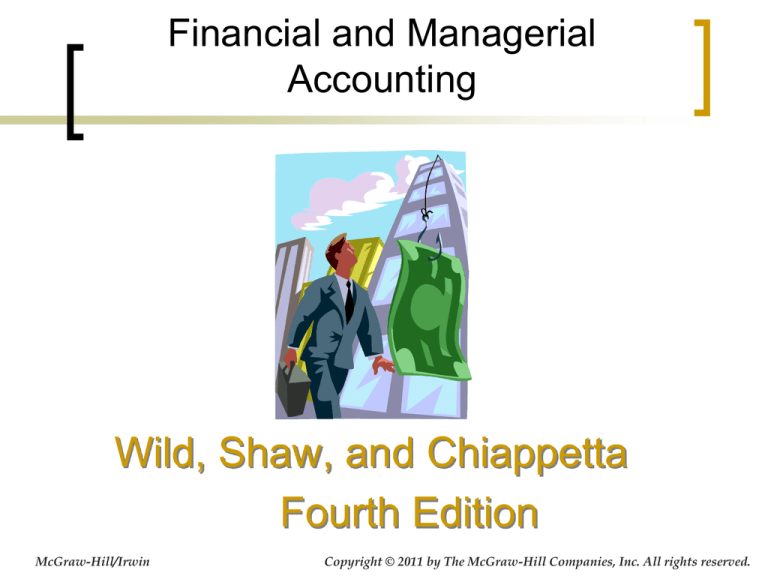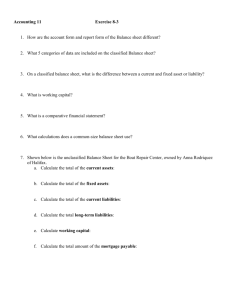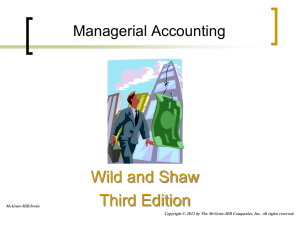
Financial and Managerial
Accounting
Wild, Shaw, and Chiappetta
Fourth Edition
McGraw-Hill/Irwin
Copyright © 2011 by The McGraw-Hill Companies, Inc. All rights reserved.
Chapter 13
Analyzing Financial Statements
Conceptual Learning Objectives
C1: Explain the purpose and identify the
building blocks of analysis.
C2: Describe standards for comparisons
in analysis.
13-3
Analytical Learning Objectives
A1: Summarize and report results of
analysis.
A2: Appendix 13A – Explain the form
and assess the content of a complete
income statement (see text for details).
13-4
Procedural Learning Objectives
P1: Explain and apply methods of
horizontal analysis.
P2: Describe and apply methods of
vertical analysis.
P3: Define and apply ratio analysis.
13-5
C1
Building Blocks of Analysis
Ability to meet
short-term
obligations and
to efficiently
generate
revenues
Ability to provide
financial rewards
sufficient to
attract and retain
financing
Liquidity
and
Efficiency
Solvency
Market
Profitability
Prospects
Ability to
generate future
revenues and
meet long-term
obligations
Ability to
generate
positive
market
expectations
13-6
C2
Standards for Comparison
When interpreting measures, we need to
decide whether the measures indicate good,
bad, or average performance. We can use
the following to make that judgment:
Intracompany
Competitor
Industry
Guidelines (rule of thumb)
13-7
C1
Tools of Analysis
Horizontal Analysis
Comparing a company’s financial condition and
performance across time.
Vertical Analysis
Comparing a company’s financial condition and
performance to a base amount.
Measurement of key
relations between
financial statement items
13-8
P1
Comparative Statements
Calculate Change in Dollar Amount
Dollar
Analysis period
Base period
–
=
change
amount
amount
Since we are measuring the amount of
the change between 2011 and 2010, the
dollar amounts for 2010 become the
“base” period amounts.
Calculate Change as a Percent
Percent
change
=
Dollar change
Base period amount
×
100
13-9
P1
Trend Analysis
Trend analysis is used to reveal patterns in data
covering successive periods.
Trend
=
percent
Analysis period amount
Base period amount
× 100
13-10
P2
Common-Size Statements
Calculate Common-size Percent
Common-size
percent
=
Analysis amount
Base amount
×
100
Financial Statement
Base Amount
Balance Sheet
Total Assets
Income Statement
Revenues
13-11
P2
CLOVER CORPORATION
Comparative (Partial) Balance Sheets
December 31, 2011
2011
Liabilities and Shareholders' Equity
Current liabilities:
Accounts payable
Notes payable
Total current liabilities
Long-term liabilities:
Bonds payable, 8%
Total liabilities
Shareholders' equity:
Preferred stock
Common stock
Additional paid-in capital
Total paid-in capital
Retained earnings
Total shareholders' equity
Total liabilities and shareholders' equity
* Percent rounded to first decimal point.
2010
Common-size
Percents*
2011
2010
$ 67,000 $ 44,000
3,000
6,000
$ 70,000 $ 50,000
21.3%
1.0%
22.2%
15.2%
2.1%
17.3%
75,000
$ 145,000
80,000
$ 130,000
23.8%
46.0%
27.6%
44.9%
20,000
20,000
60,000
60,000
10,000
10,000
$ 90,000 $ 90,000
80,000
69,700
$ 170,000 $ 159,700
$ 315,000 $ 289,700
6.3%
19.0%
3.2%
28.6%
25.4%
54.0%
100.0%
6.9%
20.7%
3.5%
31.1%
24.1%
55.1%
100.0%
13-12
P3
Liquidity and Efficiency
Current
Ratio
Inventory
Turnover
Days’ Sales
Uncollected
Acid-test
Ratio
Accounts
Receivable
Turnover
Days’ Sales
in Inventory
Total Asset
Turnover
13-13
P3
Solvency
Debt
Ratio
Equity
Ratio
Pledged Assets
to Secured
Liabilities
Times
Interest
Earned
13-14
P3
Profitability
Profit
Margin
Basic
Earnings per
Share
Gross
Margin
Return on
Total Assets
Book Value
per Common
Share
Return on
Common
Stockholders’
Equity
13-15
A1
Summarizing Results
A financial statement analysis report helps by directly
assessing the building blocks of analysis and by
identifying weaknesses in inference and by requiring
explanation. It usually consists of six sections:
Executive summary
Analysis overview
Evidential matter
Assumptions
Key Factors
Inferences
13-16
End of Chapter 13
13-17






